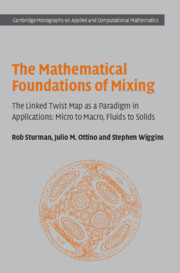 The Mathematical Foundations of Mixing
The Mathematical Foundations of Mixing Book contents
- Frontmatter
- Contents
- Preface
- Acknowledgments
- 1 Mixing: physical issues
- 2 Linked twist maps: definition, construction and the relevance to mixing
- 3 The ergodic hierarchy
- 4 Existence of a horseshoe for the linked twist map
- 5 Hyperbolicity
- 6 The ergodic partition for toral linked twist maps
- 7 Ergodicity and the Bernoulli property for toral linked twist maps
- 8 Linked twist maps on the plane
- 9 Further directions and open problems
- References
- Index
7 - Ergodicity and the Bernoulli property for toral linked twist maps
Published online by Cambridge University Press: 03 February 2010
- Frontmatter
- Contents
- Preface
- Acknowledgments
- 1 Mixing: physical issues
- 2 Linked twist maps: definition, construction and the relevance to mixing
- 3 The ergodic hierarchy
- 4 Existence of a horseshoe for the linked twist map
- 5 Hyperbolicity
- 6 The ergodic partition for toral linked twist maps
- 7 Ergodicity and the Bernoulli property for toral linked twist maps
- 8 Linked twist maps on the plane
- 9 Further directions and open problems
- References
- Index
Summary
In this chapter we apply a global geometric argument to extend the result of the previous chapter to ergodicity and the Bernoulli property for toral linked twist maps. Conditions are given such that these results hold.
Introduction
As discussed in Chapter 3, the property of ergodicity is a long way down in the ergodic hierarchy. For the strongest mixing behaviour, we would like our linked twist maps to possess the Bernoulli property. Fortunately, the Katok–Strelcyn version of Pesin theory given in Chapter 5 gives conditions to show exactly that. Recall that if the Katok–Strelcyn conditions are satisfied, and Lyapunov exponents are non-zero for every tangent vector, and for almost every point, we have the existence of local stable and unstable manifolds for almost all points in our domain for a smooth dynamical system with singularities. Furthermore, if some forward iterate of the local unstable manifold of some point intersects some backward iterate of the local stable manifold of another point, for almost every pair of points (the Manifold Intersection Property), then the ergodic partition we showed to exist in the previous chapter has only one component, and so our linked twist map is ergodic. Moreover, if every (far enough) forward iterate of the local unstable manifold intersects some (far enough) backward iterate of the local stable manifold, again for almost every pair of points (the Repeated Manifold Intersection Property), then the linked twist map has the Bernoulli property.
In this chapter we prove that both these conditions hold for toral linked twist maps, following the work of Wojtkowski (1980) and, mainly, Przytycki (1983).
- Type
- Chapter
- Information
- The Mathematical Foundations of MixingThe Linked Twist Map as a Paradigm in Applications: Micro to Macro, Fluids to Solids, pp. 194 - 216Publisher: Cambridge University PressPrint publication year: 2006


